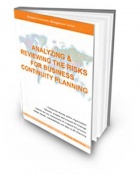From BCMpedia. A Wiki Glossary for Business Continuity Management (BCM) and Disaster Recovery (DR).
Jump to navigation
Jump to search
| 1. Key Planing Scenario (KPS) provides the BC Team with a perspective of the magnitude of disaster that an organization is willing to commit the resources to mitigate and is acceptable to the organisation. This organisation includes the Executive Management, Organization BCM Coordinator, BCP team, DRP team and the Crisis Management Team.
Related Term: Risk Appetite, Risk Likelihood, Risk Impact, Risk Rating, Risk Assessment, Risk Level, Period of Disruption, Key Disaster Scenario (This term is changed to Key Planning Scenario)
- Note (2): The Key Planning Scenario forms the basis for the development and implementation of the BC plan and recovery procedures. The key planning scenario is derived based on the list of threats identified; which the BCM Steering Committee deems the organization is vulnerable to (or likely to occur), and that, if nothing is done, will cause significant (potential) losses and subsequently, result in huge costs to recover the business. Generally, the key planning scenario should enable the organization to develop its BC plan that will address multiple threats.
- Note (3): The Key Planning Scenario is used to determine the impact to the business, and the priority with which critical business and support functions will be recovered. The recovery time lines, resources and vital records must ensure the recovery of these functions, and shall be consistent with the key disaster scenario.
- Note (4): Test and exercise scenarios should also be realistic. The scenarios developed should be consistent with the key planning scenario. For example, if an earthquake is not identified as a threat which leads to the key planning scenario, then one should not consider developing a test or exercise scenario based on an earthquake. Fire is an inherent risk to most, if not all organizations; thus, a test scenario based on a fire will be a practical choice.'
- Note (5): Worst-case disaster scenario is another term used to refer to the key planning scenario. Unfortunately, this term is often misinterpreted as implying a “dooms-day” scenario. Planning for the dooms-day scenario is not recommended as it will mean that organization needs to expand and commit significant amount of resources and funds to develop such plans and conduct exercises to improve readiness. But, the effort and resources to be committed is unjustifiable.
 Analysing And Reviewing The Risks For Business Continuity Planning
Courses
|
